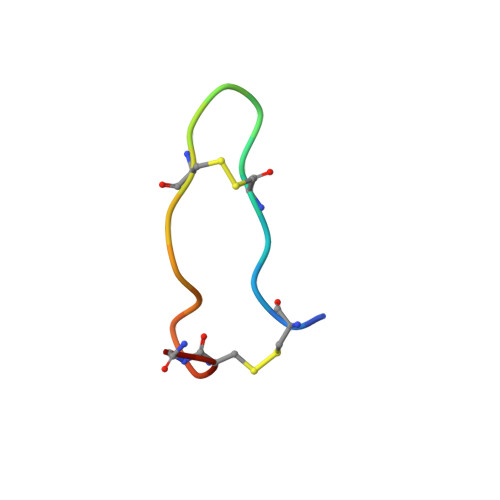PHAB toxins: a unique family of predatory sea anemone toxins evolving via intra-gene concerted evolution defines a new peptide fold.
Madio, B., Peigneur, S., Chin, Y.K.Y., Hamilton, B.R., Henriques, S.T., Smith, J.J., Cristofori-Armstrong, B., Dekan, Z., Boughton, B.A., Alewood, P.F., Tytgat, J., King, G.F., Undheim, E.A.B.(2018) Cell Mol Life Sci 75: 4511-4524
- PubMed: 30109357
- DOI: https://doi.org/10.1007/s00018-018-2897-6
- Primary Citation of Related Structures:
6AZA - PubMed Abstract:
Sea anemone venoms have long been recognized as a rich source of peptides with interesting pharmacological and structural properties, but they still contain many uncharacterized bioactive compounds. Here we report the discovery, three-dimensional structure, activity, tissue localization, and putative function of a novel sea anemone peptide toxin that constitutes a new, sixth type of voltage-gated potassium channel (K V ) toxin from sea anemones. Comprised of just 17 residues, κ-actitoxin-Ate1a (Ate1a) is the shortest sea anemone toxin reported to date, and it adopts a novel three-dimensional structure that we have named the Proline-Hinged Asymmetric β-hairpin (PHAB) fold. Mass spectrometry imaging and bioassays suggest that Ate1a serves a primarily predatory function by immobilising prey, and we show this is achieved through inhibition of Shaker-type K V channels. Ate1a is encoded as a multi-domain precursor protein that yields multiple identical mature peptides, which likely evolved by multiple domain duplication events in an actinioidean ancestor. Despite this ancient evolutionary history, the PHAB-encoding gene family exhibits remarkable sequence conservation in the mature peptide domains. We demonstrate that this conservation is likely due to intra-gene concerted evolution, which has to our knowledge not previously been reported for toxin genes. We propose that the concerted evolution of toxin domains provides a hitherto unrecognised way to circumvent the effects of the costly evolutionary arms race considered to drive toxin gene evolution by ensuring efficient secretion of ecologically important predatory toxins.
Organizational Affiliation:
Institute for Molecular Bioscience, The University of Queensland, St Lucia, QLD, 4072, Australia.














